Overview Of ICO Coti - Crypto Currency COTI
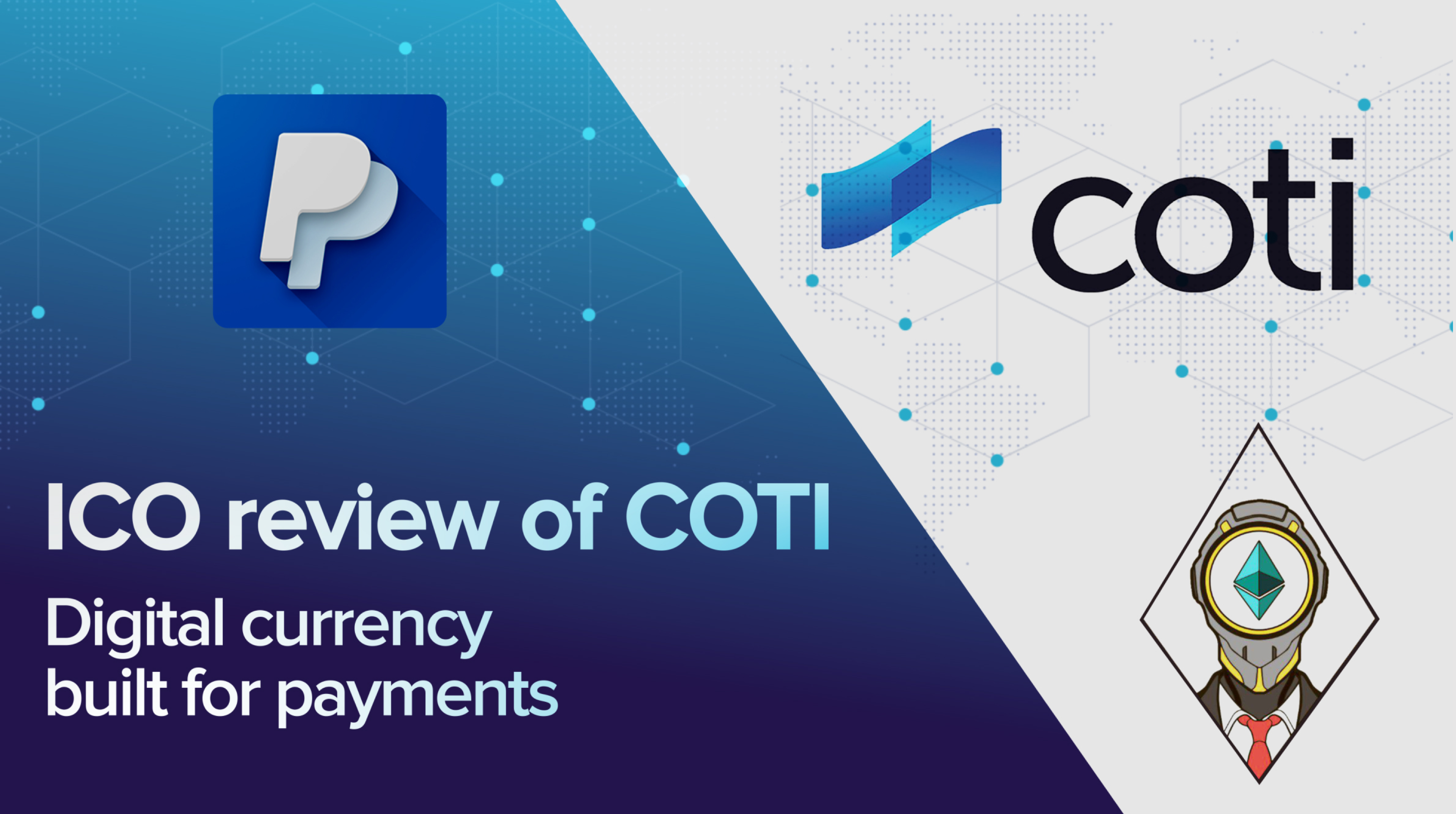
Product Coti
What is the meaning of the project?
"Coti" (Currency Of The Internet) is a decentralized global payment system with its own crypto currency for:
merchant payments: payment for goods and services of sellers on payment cards (including virtual ones), using popular payment systems such as PayPal, as well as in crypto-currencies, including COTI's own currency,
p2p-payments: direct transfers of funds between participants. It can also be transfers via payment cards, transfers in other crypto-currencies, transfers in the COTI crypto currency.
All these types of payments will be available in payment gateways on the sites of sellers (the gateways are implemented as iFrame - the html form embedded in the site for payment) and in a single purse Coti, implemented as a web application and mobile application.
The Coti project is focused primarily on meeting the needs of sellers and buyers, addressing their current problems.
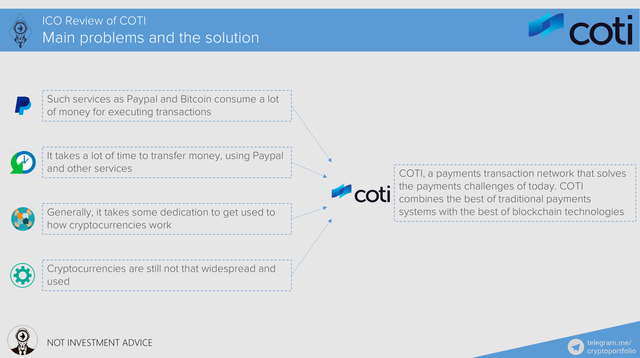
The team distinguishes the following problems in payments:
Traditional payment systems (Visa / Mastercard) have numerous shortcomings - from high commissions (maintenance, transactions, conversion) to a low level of transaction approval. In addition, about 2 billion people are not served by banks (unbanked people). Also, the user of payment cards does not control exchange rates and his cards do not support the exchange of funds for crypto-currencies.
On the other hand, crypto-currencies such as bitcoyne faced network congestion, which led to scalability problems, high commissions and increased transaction speed.
The project Coti solves these problems and combines the best in traditional banking systems with all the best digital currencies in the world.
The main advantages of Coti:
- Tens of thousands of transactions per second and instant transfers are provided by its own distributed registry, called Cluster. It is based on the distributed register DAG (directed acyclic graph) technology [1] [2] [3] . DAG, as well as block system - distributed registry technology (DLT, distributed ledger technology).
Unlike blocking technology, when a lot of transactions are assembled into one block and after a while the block is added to the chain, DAG takes each record and immediately adds it to the chain (each new transaction confirms the two previous transactions). Each new transaction must be tied to the two previous ones to become part of the registry. Moreover, the inclusion of new transactions occurs asynchronously and simultaneously (in contrast to the linear process in the blockroom) - and this solves the basic problem of scalability.
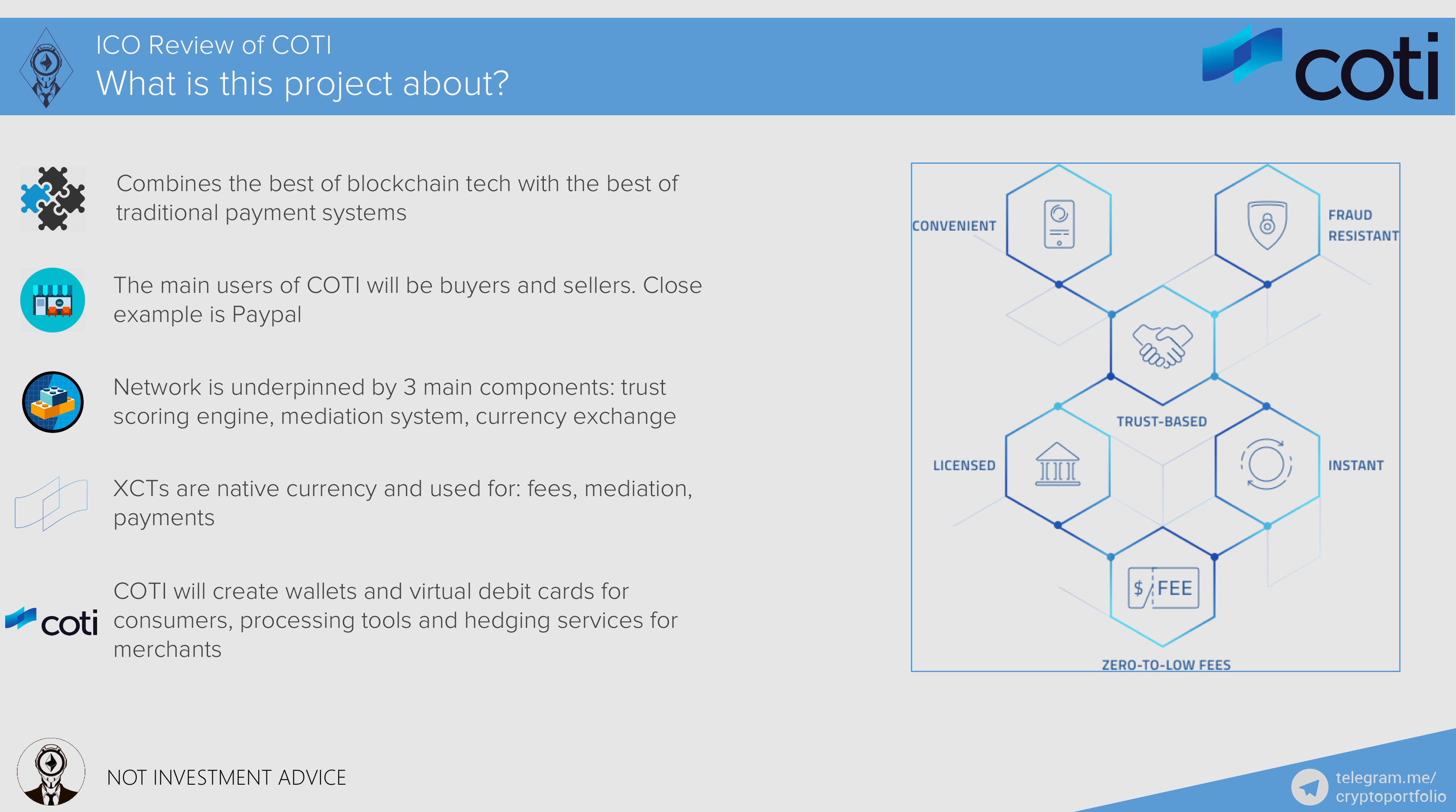
Thus, a "transaction tree" is formed and a high transaction speed is provided.
The mechanism of multiple transactions confirmation in DAG-based crypto currency allows to increase the reliability of payments and reduce the likelihood of a "double waste". IOTA ($ 2.9 billion capitalization, used for the Internet of things, IoT) uses the Tangle protocol based on the DAG and has some advantages over block technology . IOTA has entered into agreements with Microsoft and Samsung and it is called a crypto currency with unlimited scalability and zero commission.
In technologies such as DAG, the increase in network participants directly affects the improvement of scalability. This creates a positive correlation between the number of network users and the speed of transaction confirmation.
The throughput of Coti is tens of thousands of transactions per second.
- Zero commission for buyers and very low (close to zero) commission for sellers, support for high-frequency micropayments . The advantage of DAG technology is not only the speed of transactions, but also the ability to operate the network without commissions (by increasing the ease of mining). Thus, DAG-technology makes it possible to make high-frequency micropayments, for example, less than 1 centimeter in size. And such advantages can not be provided by any other crypto currency. After all, for heavy blockchain systems, microtransactions are unprofitable , since they involve a high commission, as well as a low processing speed and confirmation.
- Convenient payment ecosystem for sellers and buyers. The advantage of the project is that it is not just a new crypto currency, but a whole payment ecosystem, which includes 4 key components:
Based on the DAG's own registry "Cluster" and the consensus "Trust Chain", based on the rating (points) of trust of participants. This ensures fast transactions (especially for participants with a high trust rating), as well as low costs and commissions of the system.
Scoring mechanism (Trust Scoring Engine). Evaluates the interaction between buyers and sellers, giving each participant a rating of trust.
Mediation System. It resolves disputes between participants, using a crowdsourcing network of participants with high confidence ratings and reputation in the network, the science of data, game theory. Allows you to resolve disputes fairly and efficiently - without increasing transaction costs. In addition, sellers and buyers can optionally use escrow accounts. If the buyer requires a refund and wins the dispute, the funds are written off from the seller's reserve stock, or (if that stock is not enough) are provided from the Reserve Credit Facility of the Coti system simultaneously with the formation of the seller's debt to that fund.
Exchange for currency exchange. The ability to freely convert funds with Fiat support and crypto currency. Complemented by the automated work of a market maker to maintain fair profitable courses.
In addition, the team plans to cover the maximum number of countries in which payments to end users will be made and receive all necessary authorizations for processing payments, exchanging currencies and e-wallet services, and ensuring compliance with KYC / AML requirements for all participants in the global network.
The innovative Chain Consensus Algorithm is a combination of Proof-of-Work and Proof-of-Stake algorithms and encourages participants with a higher Trust Score rating to have a faster process of verifying their transactions (higher rating - higher transaction priority in the Cluster registry). The trust rating is based on the volume of transactions, the volume of transactions in won / lost disputes, and on ratings assigned by other participants.
Security and reliability of payments are provided by the following types of nodes (network nodes):
Full nodes: the main system members who support the Cluster registry network and provide payments. They receive signed wallet transactions and check them for spam, extract data on the trust rating, determine the nodes to confirm new transactions, give approval for the inclusion of transactions in the Cluster registry.
DSP Nodes (Double Spend Prevention, Nodes to prevent double expenditure ). These nodes support an updated copy of the Cluster registry and conduct transaction monitoring to avoid double spending.
Historical nodes (History nodes). Store the early parts of the Cluster registry, the full history of the account can be downloaded from the historical node. Each part for storage is transferred to historical nodes after Clusterstamp - fixing the checkpoint, which the parties can return in case of disputes. During the Clusterstamp, the balance of each account is aggregated and calculated based on unconfirmed transactions that become the genesis transactions in the next generation of Cluster. Also, during Clusterstamp, an audit is performed to ensure that the COTI tokens contained in Clusterstamps are equal to the total number of COTI tokens in circulation.
All nodes are rewarded for their work.
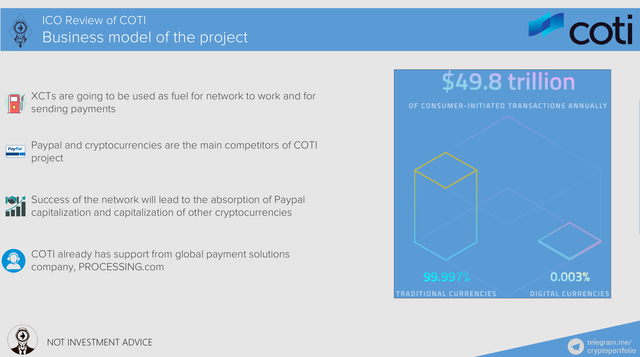
The Coti team made a very detailed description of the project and its technical part in the documents posted on the site "Business Overview", "Technical Whitepaper", "Token Economy".
Product
80%
The market where Coti will work
Is there a market and what is its size in US dollars?
The total world annual volume of consumer transactions is $ 49.8 trillion, of which 0.003% is made in crypto-currencies (information from the project website, without official sources).
Currently, more than 1.6 billion people make on-line payments . The volume of on-line payments exceeded $ 2 trillion in 2016 and is expected to double by 2021.
Particularly noteworthy is that according to the BI (Business Insider) report for the period 2015-2020, the average annual growth of mobile on-line payments is expected to be 40%, the volume of such payments will grow to $ 128 billion by 2021 , and the number of payments will grow at about the same rate and will be about 150 million people by 2021.
About 16% of transactions in the B2C sector are cross-border payments. Their share in the total volume of payments will grow to 30% by 2020 and the volume of such payments will reach $ 1 trillion . Such payments are characterized by high commissions and a high percentage of refusal (with 31% of all transactions for which a refusal is received - false erroneously rejected refusals). According to some reports, the volume of erroneously rejected transactions already reaches $ 118 billion per year, which is 13 times higher than the total annual loss from card fraud ($ 9 billion) .
Market
100%
Economy of Token Coti
Why do I need a token in the system?
COTI - crypto currency.
Ticker: COTI.
The type of the token according to the technological standard: initially COTI will be an ERC20 token. These tokens will then be exchanged for the tokens of their own distributed cluster "Cluster", which is based on DAG technology.
The type of the token by functionality: currency.
Hard Cap / Soft Cap: hard cap $ 30 million (indicated in whitepaper, support in telegram chat answered that this data will be known later).
The percentage of tokens that will be sold to investors: 42% (42% on the site, 30% in whitepaper, support in telegram chat answered that the correct figure is 42%).
Date Private Sale / Pre-Sale:While Private Sale is active with a minimum contribution of 50 thousand dollars and the price of the tote COTI = 0,079 USD. In April 2018, Public Pre-Sale will be held with a token price of 0.083 USD and Public sale with a token price from 0.087 USD to 0.1 USD. The minimum payments for Public Pre-Sale and Public sale - 25 USD.
Price of the token on Private Sale: 1 COTI = 0.079 USD.
The price of the token on the Public Pre-sale: 1 COTI = 0.033 USD.
The price of the token on the ICO: on the ICO (Public Sale): 1 COTI = from 0.087 USD to 0.1 USD. Tokens will be sold in four tranches / stages, each tranche lasts a week or until all the tokens identified for this trench are purchased (final approved data is not yet available, we advise you to specify this information in telegram chat).
Date of ICO: April 2018 (the exact date is not yet fixed).
Minimum / Maximum contribution: Minimum payments for Public Pre-Sale and Public sale - 25 USD. There are no restrictions on the maximum contribution.
Bonuses on the stage of PRE-ICO / Private Sale / ICO: On Private Sale the price of the token with a discount of 26% to the price of the ICO. On Public Pre-sale, a 20% discount on the price of the ICO (the information obtained does not exactly match the specified price of the token on the priveteille and the presale, this is due to the fact that some ico parameters are not yet defined, the ihodl team advises to update the current data from the telegram administrators, chat).
Will the tokens (investors / teams / advisers) be frozen and for how long:
50% of investors' tokensails will be blocked for 6 to 24 months. All tokens of the team, advisers and investors on the priveteille will be blocked for a period of 6 to 24 months (the deadline depends on the discounts that they prefer to receive - such information is not yet available). Investor tokens on ico without blocking, but an additional 5% discount will be granted for the lock period of 6 months, 10% for 12 months, 20% for 24 months.
Token Economy
60%
Competitiveness of Coti
Who are the competitors? What does this project want to be better? Strengths and weaknesses
in comparison with competitors.
The competitors of the project are traditional payment systems (serving plastic cards) and crypto-currencies. The following figure shows the main advantages announced by the project for competitors and the requirements for a new generation payment system:
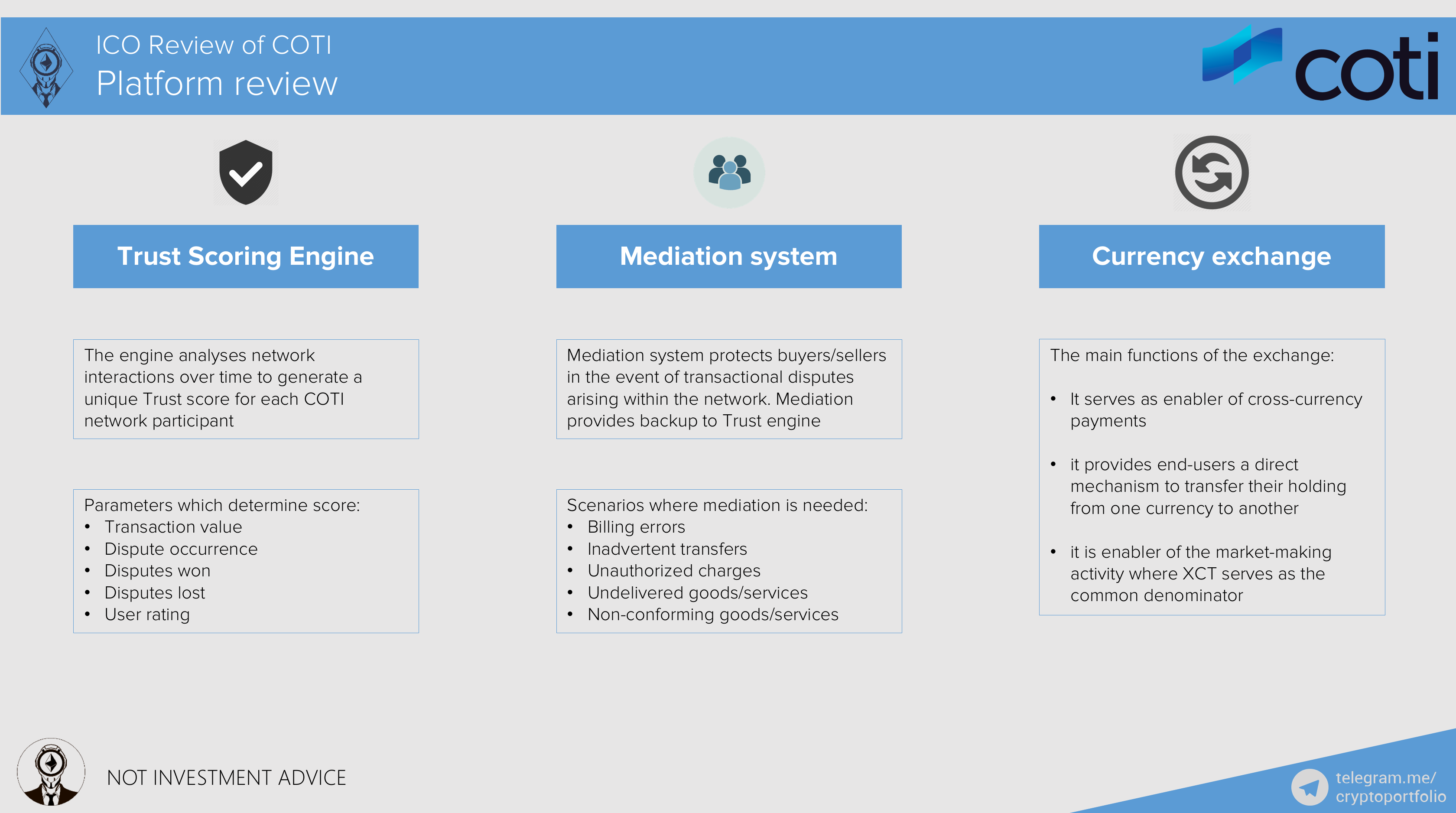
The ihodl team notes that the Coti project is simultaneously competing with electronic payment systems such as PayPal (electronic money), but the project team does not consider such competition in its documentation.
The Coti team states in telegraph-chat that the test results confirming the TPS indicator will soon be published.
Decentralized management protects the system from a monopoly on transaction confirmation, which increases its reliability and the level of trust in the long term.
Reliability and high level of transaction approval will be achieved by common transparent standards for deposits / withdrawals / commissions / transaction confirmations.
Protection of the buyer-seller is carried out at a lower cost than payment systems do, which hold reserves for resolving disputes and complaints. Most crypto currencies do not provide such protection at all, focusing only on the transfer of funds.
Zero-low commissions are unable to provide most of the crypto-currencies that are experiencing network congestion problems and have commissions ranging from a few cents to a few dollars. Cluster, based on DAG technology, provides high performance (throughput) of 10,000+ TPS at the same time with good scalability (increasing the number of participants directly affects the scalability, more participants - more TPS and transaction speed). Payment system commissions are also high, especially in cross-border payments and payments in jurisdictions with increased economic risk.
Trust is provided by the network participants themselves (three types of nodes) and trust ratings that encourage bona fide participants to make payments faster. Also, it is possible to use escrow accounts. There is no need to involve a costly chain of intermediary agents, as payment systems do. Traditional crypto currencies represent a more certain layer for cash settlement, without providing a complete solution for payments.
Ease of use is achieved by the implementation of a multi-currency purse (at the same time as a phi-one and a crypto-currency), as well as by an internal exchange and a market maker for currency exchange. This is the main difference from crypto-currencies, which rely on payments exclusively in their own currency.
Compliance is achieved by the active work of the project in all significant jurisdictions where customers will make payments and exchange of currencies. Most crypto-currencies in this sense are unregulated.
Direct competitors among existing crypto-currencies with a register based on DAG technology:
IOTA (MIOTA), crypto currency for Internet-things with a capitalization of $ 2.9 billion.
Byteball Bytes (GBYTE), a crypto currency with a capitalization of $ 112 million.
Nano (NANO), a crypto currency with a capitalization of $ 650 million.
As a new ico-projects, working on promising crypto-cash distributed registers and making direct competition to Coti, it is possible to single out the Hedera Hashgraph project , which also implements all the above advantages of using DAG technology and showed colossal performance up to 500,000 TPS. According to icodrops.com, the project has already collected not $ 18 million pre-sale.
Also, it is worth noting that in May 2017 the news came out that Waves is launching the first payment gateway for operations in euros thanks to a financial agreement with a partner that works in this area. The partner is licensed, and provides all the regulatory requirements for the receipt of funds in and out of the blockroom. [4] [5] . This means that leading crypto-currencies will soon also provide sellers with a single convenient payment solution, where payment gateways will be integrated, allowing to pay also in the currency of the currencies.
Competitiveness
70%
Progress on This Coti Moment
Where are they relative to their road map? What have you already done?
Currently, Coti is working on obtaining all necessary licenses for the functioning of the payment system and exchange for currency exchange in various jurisdictions of end-users (buyers).
In early 2018, the team creates a small test mini-network, launches a beta version of the purse and exchange for currency exchange.
In the 4th quarter of 2018 :
It is planned to launch a test network (testnet),
ready beta versions of a wallet full of nodes, DSP nodes and historical nodes, as well as a prototype Trust Score server.
In the 2nd quarter of 2019 :
start of the main network (mainnet),
launching a wallet,
run full, DSP and historical nodes,
launch the Trust Score server,
A prototype of the Mediation System is ready.
In Q4 2019 :
A decentralized KYC / AML solution is launched for the participants of the payment network,
the launch of a mediation-reconciliation system,
launching an API (application programming interface) for processing payments by merchants,
launching an iFrame (inline frame, embedded frame, or a "floating" frame - an area on the site (window) in which another web page is visible) that will be embedded in the merchant's websites in order to process payments.
launch of the exchange for currency exchange.
2020:
launching virtual debit cards that will make payments using large payment systems (as most modern payment systems like QIWI, Webmoney, etc. do).
the launch of a hedging service that will allow large sellers to hedge the risks of fluctuating the price of COTI.
the launch of a regular invoicing service (repetitive payments).
2021:
expansion of services for sellers (new services, including payment for goods to suppliers, as well as payment of wages through the Coti system), creation of a foundation for third-party developers' incentives, and the launch of the SDK (Software Development Kit) for integration into the mediation-reconciliation system other payment systems.
Progress on This Moment
WebSite https://coti.io
Whitepaper: https://coti.io/en/files/COTI-technical-whitepaper.pdf